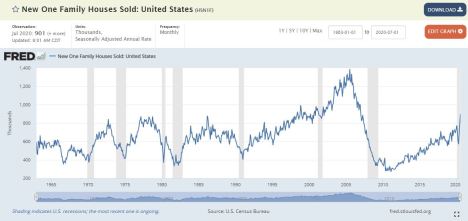Vital Statistics:
|
Last |
Change |
| S&P futures |
3357 |
-16.6 |
| Oil (WTI) |
42.54 |
-0.32 |
| 10 year government bond yield |
|
0.65% |
| 30 year fixed rate mortgage |
|
2.89% |
Stocks are down this morning after the Fed minutes revealed pessimism about the economy. Bonds an MBS are up.
Initial Jobless Claims rose back above the 1 million market last week.
The Fed released its minutes from the July FOMC meeting yesterday. The big revelation was a moderating of economic expectations into the end of the year. The money quote: (note this is from the staff economists)
The projected rate of recovery in real GDP, and the pace of declines in the unemployment rate, over the second half of this year were expected to be somewhat less robust than in the previous forecast.
There was also discussion about the concept of yield caps, in other words the Fed targeting specific maturities in the Treasury market to keep the 10-year or 5-year bond yield below a certain target level.
A majority of participants commented on yield caps and targets—approaches that cap or target interest rates along the yield curve—as a monetary policy tool. Of those participants who discussed this option, most judged that yield caps and targets would likely provide only modest benefits in the current environment, as the Committee’s forward guidance regarding the path of the federal funds rate already appeared highly credible and longer-term interest rates were already low.
This is generally good news, at least for those that still cling to the idea that interest rates should be determined by a market. Still, the Fed and the US continues its “slouching towards Japan” strategy. Given the theory that increases in government debt as a percentage of GDP creates sluggish growth and low rates, not inflation (certainly borne out in Japan and Europe), low rates may be around for quite some time.
Mortgage Applications decreased 3.3% last week as rates rose. The purchase index rose by 1%, while refis fell by 5%. “Positive economic data reported last week on retail sales, as well as a large U.S. Treasury auction, drove mortgage rates to their highest level in two weeks,” said Joel Kan, MBA Associate Vice President of Economic and Industry Forecasting. “The rise in rates dampened refinance activity, but purchase applications continued their strong run and were 27 percent higher than a year ago – the third straight month of year-over-year increases.”
There were a lot of rumors going around that the GSEs are looking to delay the 50 basis point LLPA for mortgage refinances. The industry has been dead set against it, and we have seen bipartisan opposition to it. The industry’s main gripe is the short fuse: loans that were locked before the announcement but expected to close after would require the lender to eat the additional cost. A longer runway (say Jan 1) would prevent this. Another option is to apply the LLPA on locks after Sep 1. The word on the street is that the next shoe to drop will be investment properties, so we could see higher LLPAs there in the future.
Fannie CEO Hugh Frater and Freddie CEO David Brickman threw cold water on that idea in a blog post.
Contrary to much of the criticism we have received since making this announcement, this will generally not cause mortgage payments to “go up.” The fee applies only to refinancing borrowers, who almost always use a refinancing to lower their monthly rate…
Some have asserted that this price adjustment could impact borrowers by as much as $1,500—but this life of the loan estimate is a misrepresentation of how this cost would be applied. For an average refinanced mortgage, we estimate a reduction in savings of about $15 per month, meaning refinancing homeowners who were previously saving $133 on their monthly payments will now save $118 per month, on average.
This estimate also assumes lenders pass on the entire fee to borrowers. That is up to them. If they do not, the $15-per-month figure would go down, potentially to zero.
Does this sound like someone reconsidering the idea? It sounds more like “I am altering the deal. Pray I don’t alter it any further.”
Despite the economic gloom, renting households are making their rent payments, according to the National Multifamily Housing Council. Almost 87% of renters have paid August rent, which is down about 2% from a year ago. Note that NYC is bringing up the rear at a sub-80% rate. Writer James Altucher wrote an interesting essay about why this time is indeed different for NYC.
Filed under: Economy, Morning Report | 72 Comments »







